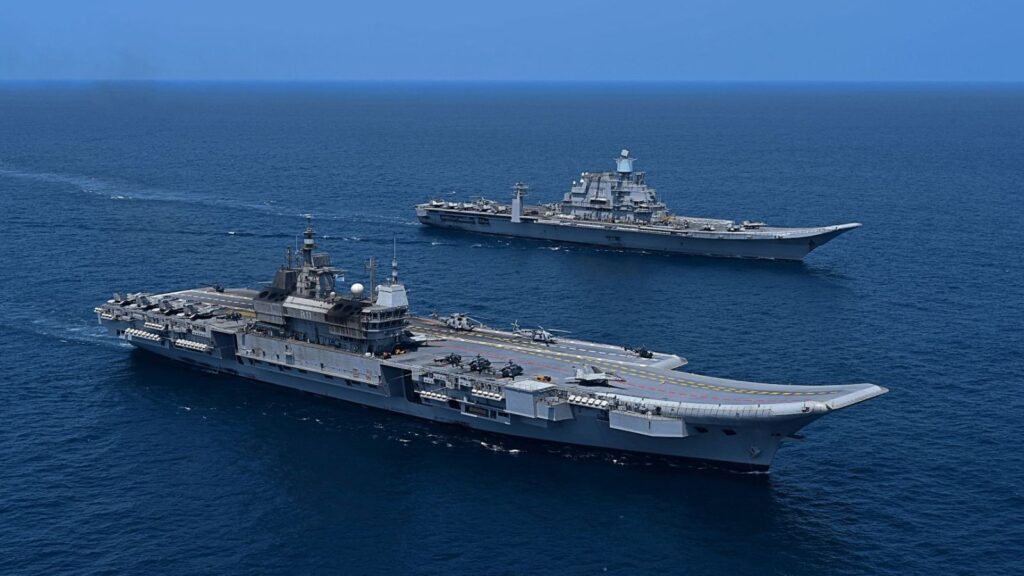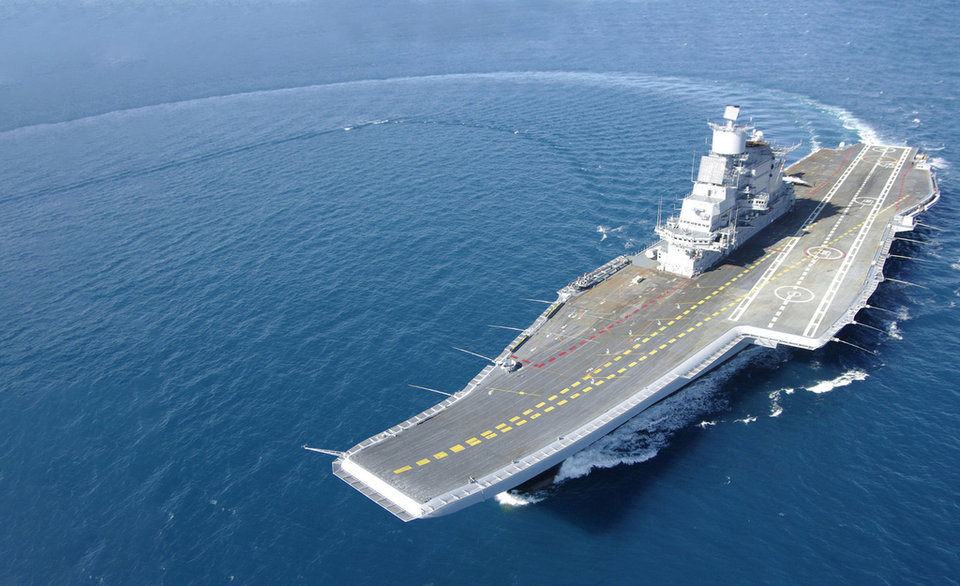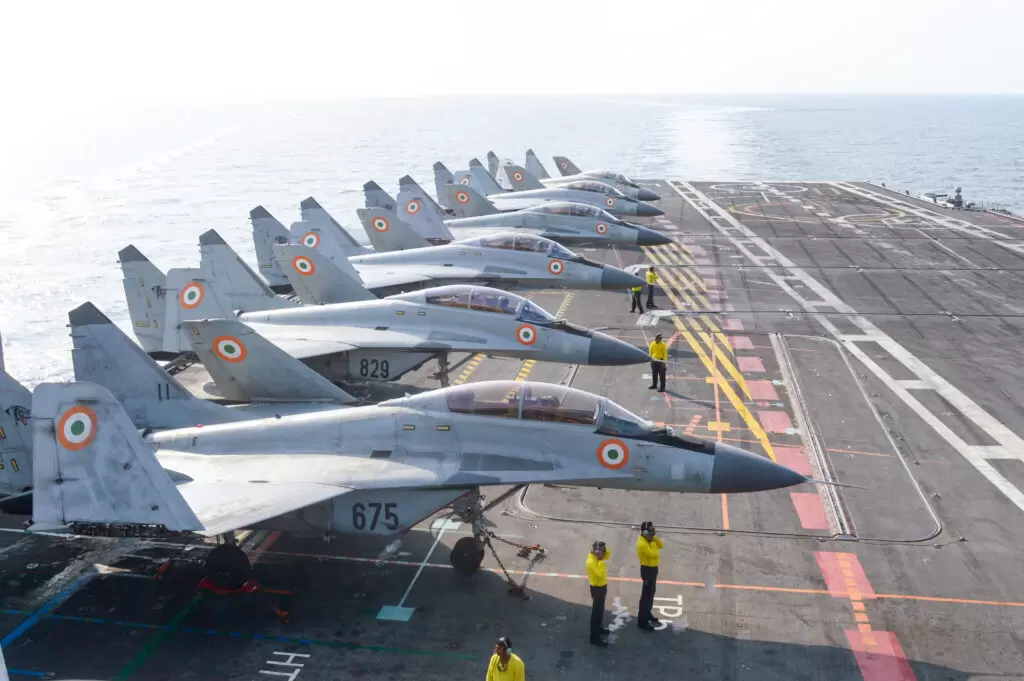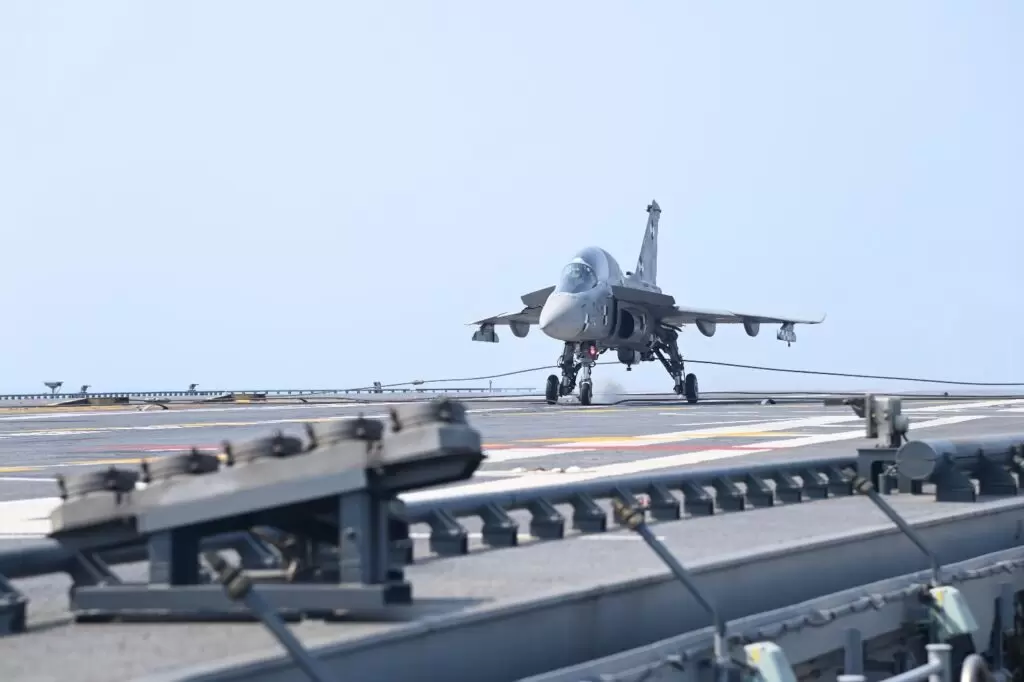INS Vikrant: 4.5 Acres of Sovereign Indian Power, Sailing at 28 Knots to Park an Airbase at the Enemy’s Doorstep | What Makes it So Deadly?

Table of Contents
- Introduction
- History and Development of INS Vikrant
- Indigenous Design and Industrial Contribution
- Key Capabilities and Specifications
- Operational Achievements
- Humanitarian Assistance and Disaster Relief Role
- Strengthening India’s Maritime Self-Reliance
- Conclusion
Introduction
INS Vikrant, India’s first indigenous aircraft carrier, stands as a proud milestone in the nation’s maritime journey. Designed by the Indian Navy’s Warship Design Bureau and built by Cochin Shipyard Limited (CSL), it is the largest and most complex warship ever built in India. Commissioned on 2 September 2022 by Prime Minister Narendra Modi, INS Vikrant is a reflection of India’s strength, skill, and self-reliance.

During Diwali 2025, the Prime Minister celebrated the festival onboard INS Vikrant, acknowledging the courage and service of the Indian Navy. The ship hosted the Prime Minister for an overnight sea sortie from 19 to 20 October 2025, featuring a series of operational demonstrations such as day and night air power displays, anti-submarine rocket firing, replenishment at sea, and interactions with the crew.
History and Development of INS Vikrant
INS Vikrant carries forward the proud legacy of its predecessor, INS Vikrant (R11), which was decommissioned in 1997. The earlier ship had played a major role in the 1961 Goa Liberation and the 1971 Indo-Pak War.
The new Vikrant, also called IAC-1, began its construction journey when its keel was laid in February 2009 at Cochin Shipyard Limited. The ship was launched in August 2013, underwent maiden sea trials in August 2021, and was finally commissioned in 2022. With this achievement, India joined an elite group of nations capable of designing and building their own aircraft carriers.

Indigenous Design and Industrial Contribution
A defining feature of INS Vikrant is its 76% indigenous content, making it a true representation of “Atmanirbhar Bharat”. Approximately 30,000 tonnes of high-grade steel were supplied by Steel Authority of India Limited (SAIL).
The project involved over 550 Original Equipment Manufacturers (OEMs) and 100 MSMEs. This extensive participation generated about 2,000 direct jobs and 12,500 indirect jobs, providing a major boost to India’s industrial and defence ecosystem.
The carrier is powered by advanced automation and engineering that highlight Indian expertise in shipbuilding.
Watch | Two Mig 29s take off simultaneously from the flight decks of INS Vikrant and INS Vikramaditya side by side. What is reassuring sight! #IndianNavy #India #MakeInIndia pic.twitter.com/Mj3zJy8gEQ
— PuneNow (@itspunenow) April 22, 2024
Key Capabilities and Specifications
INS Vikrant showcases the scale of India’s growing maritime power.
- Length: 262.5 metres
- Width: 61.6 metres
- Displacement: Around 45,000 tonnes
- Propulsion: Four gas turbines generating about 88 MW of power
- Maximum Speed: 28 knots
- Crew Capacity: 1,600 personnel, including women officers and sailors
- Compartments: Approximately 2,200
- Aircraft Capacity: Up to 30 aircraft, including MiG-29K, Kamov-31, MH-60R, MiG 29 KUB, Chetak and ALH helicopters
Source: Public Information Bureau
The ship operates on the Short Take-Off But Arrested Recovery (STOBAR) system and can generate electricity sufficient to power 5,000 households. Its internal wiring is long enough to stretch from Kochi to Kashi, showcasing the engineering complexity behind its design.

Operational Achievements
Since its commissioning, INS Vikrant has been central to India’s naval operations and training.
- Maiden Sea Trials (August 2021): Validated propulsion, navigation, and weapon systems.
- First Landings (February 2023): Successful operation of LCA (Navy) and MiG-29K aircraft.
- Night Landings (May 2023): Demonstrated readiness for complex missions in low-visibility conditions.
- Final Operational Clearance (2024): Achieved after 750+ hours of flight operations.
- MILAN 2024: Participated in India’s largest multilateral naval exercise with over 36 ships and 55 aircraft from 47 friendly nations.
- Presidential Visit (November 2024): The President of India witnessed flight and missile demonstrations.
- Exercise Varuna 2025: Conducted joint operations with the French Navy’s Charles de Gaulle Carrier Group.
- Operation Sindoor: Played a critical role in deterring the Pakistan Navy during operations in the northern Arabian Sea.
- Humanitarian Operation (March 2025): Conducted a medical evacuation of three injured crew from MV Heilan Star off the coast of Goa.
Humanitarian Assistance and Disaster Relief Role
Beyond warfare, INS Vikrant serves as a vital platform for Humanitarian Assistance and Disaster Relief (HADR). With its advanced automation, strong power generation, and aviation facilities, the ship can act as a mobile command centre, hospital, or supply hub during crises.
Its recent operation to rescue injured crew members from MV Heilan Star, 230 nautical miles west of Goa, highlighted the Indian Navy’s commitment to humanitarian service beyond national waters.
The carrier’s role aligns with India’s SAGAR vision – Security and Growth for All in the Region, strengthening India’s position as the “Preferred Security Partner” in the Indian Ocean.
Strengthening India’s Maritime Self-Reliance
The creation of INS Vikrant is a symbol of India’s defence self-reliance. Designed by the Warship Design Bureau and built by Cochin Shipyard, it involved major Indian firms such as BEL, BHEL, GRSE, Keltron, Kirloskar, Larsen & Toubro, and Wartsila India.
The indigenous warship-grade steel was jointly developed by the Indian Navy, DRDO, and SAIL – making India self-sufficient in this critical area.
In April 2025, India signed a ₹63,000 crore deal with France to procure 26 Rafale-Marine jets to further strengthen INS Vikrant and INS Vikramaditya’s air wings. These jets will significantly enhance India’s maritime strike capabilities.
As of December 2024, India had built 133 ships and submarines domestically, with 63 of 64 new warships under construction within the country. This reflects India’s commitment to its long-term goal of building a powerful, indigenous Navy.

Conclusion
INS Vikrant is more than just a warship – it is a statement of India’s technological strength, maritime ambition, and national pride. The indigenous aircraft carrier demonstrates India’s ability to design, build, and operate world-class naval platforms.
With the ship’s growing operational role, India now stands among the few nations capable of building such advanced carriers, paving the way for future indigenous defence projects. INS Vikrant will continue to inspire generations and strengthen India’s position as a leading maritime power in the Indo-Pacific.









